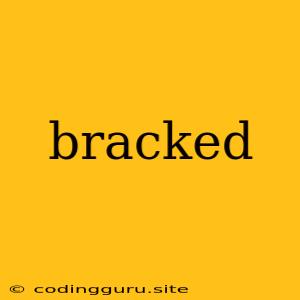What Are Brackets and Why Are They So Important?
Brackets are a fundamental part of programming languages, used to define the structure and order of operations in code. They serve as essential tools to group code elements, control flow, and improve code readability. Whether you're working with JavaScript, Python, C++, or any other programming language, understanding brackets is crucial for writing clear, concise, and functional code.
Types of Brackets and Their Functions
There are three main types of brackets commonly used in programming:
-
Curly Brackets (
{}): These are used to define blocks of code, such as function bodies, loops, and conditional statements. They enclose a group of instructions that should be executed together. -
Square Brackets (
[]): These are used to access elements within arrays, lists, or other data structures that represent collections of data. -
Parentheses (
()): These are used for various purposes, including:- Function Calls: To pass arguments to functions and invoke their execution.
- Mathematical Operations: To define the order of operations in mathematical expressions.
- Conditional Statements: To enclose conditions in if-else statements.
Examples of Brackets in Action
Let's illustrate the use of brackets with some code examples:
1. Defining a Function with Curly Brackets:
function calculateSum(a, b) {
// The code within the curly brackets defines the function's behavior
return a + b;
}
2. Accessing an Array Element with Square Brackets:
numbers = [1, 2, 3, 4, 5]
print(numbers[2]) # Outputs 3, the third element of the array
3. Function Call with Parentheses:
int result = pow(2, 3); // Calls the pow function with arguments 2 and 3
Importance of Proper Bracket Placement
Brackets are crucial for ensuring code clarity and functionality. Inconsistent or incorrect bracket placement can lead to syntax errors and unpredictable program behavior. Here are some key points to remember:
-
Pairing: Every opening bracket must have a corresponding closing bracket. Mismatched brackets will result in a syntax error.
-
Nesting: Brackets can be nested within each other to create complex code structures. Ensure each nested bracket is correctly paired and has the intended scope.
-
Indentation: Consistent indentation within brackets helps to visually structure your code and improve readability.
Troubleshooting Bracket Issues
If you encounter errors related to brackets, here are some common causes and solutions:
-
Missing Bracket: Check for any missing opening or closing brackets.
-
Incorrect Bracket Type: Ensure you are using the correct type of bracket for the specific context (curly, square, or parentheses).
-
Nesting Errors: Carefully review the nesting of brackets to ensure proper pairing and scope.
-
Code Editors and IDEs: Modern code editors and integrated development environments (IDEs) often offer syntax highlighting and bracket matching features to help you identify and correct bracket errors.
Conclusion
Brackets are essential building blocks in programming, defining code structure and order of operations. Mastering the use of different bracket types and their placement is crucial for writing correct, clear, and functional code. By understanding the role of brackets and following good coding practices, you can avoid common bracket-related errors and improve the overall quality of your code.
